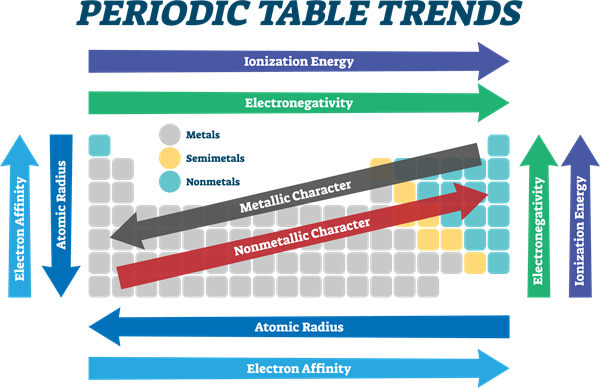PDF chapter test TRY NOW
Periodicity:
The electronic configurations of elements help us to describe the periodic recurrence of physical and chemical properties. Anything which repeats itself after a fixed interval is called Periodic, and this behaviour is called Periodicity.
Atomic radius, ionic radius, ionisation energy, electronegativity, and electron affinity are called Periodic properties.
The modern periodic table's primary significance is that it provides a fair conclusion of the common characteristics and trends within a group or a period, allowing us to predict the properties of any element with considerable accuracy, even if that element is unknown to us.
Let's take a look at the periodic trend of some of these properties.

Atomic radius:
The atomic radius is defined as the distance between the nucleus centre and the outermost shell containing the valence electron.
The radius of a separated atom is not possible to measure directly.
The atomic radius of the elements decreases from left to right, whereas the atomic radius of the groups increases from top to bottom.
The positive charges impose a strong attraction over the electrons, and thus the electron cloud shrinks towards the nucleus, which results in a decrease in the atomic size.
Ionic radius or radii:
The ionic radius is the distance between the nucleus's centre and the point where it exerts an effect on the ion's electron cloud.
The ionic radius of the elements decreases from left to right, whereas the ionic radius of the groups increases from top to bottom.
Ionisation energy:
Ionisation energy is the minimum energy necessary to remove an electron from an isolated gaseous atom in its ground state to generate a cation. It's also known as ionisation enthalpy.
It's expressed in kJ/mol. Greater the ionisation energy, it is more difficult to remove the electron.
From left to right, the ionisation energy of the elements increases, whereas along with the groups, from top to bottom, the ionisation energy decreases.
Electron affinity:
The amount of energy liberated when an isolated gaseous atom gains an electron to form its anion is known as electron affinity.
Electron affinity, like ionisation energy, increases from left to right in a period and decreases from top to bottom in a group.
Electronegativity:
An element's electronegativity measures its atom's tendency to attract the shared pair of electrons towards itself in a covalent bond.
Electronegativity is determined by various experimental data, including bond energy, ionisation potential, electron affinity, etc.
From left to right in the periodic table, the electronegativity increases due to an increase in nuclear charge, attracting electrons more strongly. Conversely, on moving down a group, the electronegativity of the elements decreases because of the increased number of valence shells.
